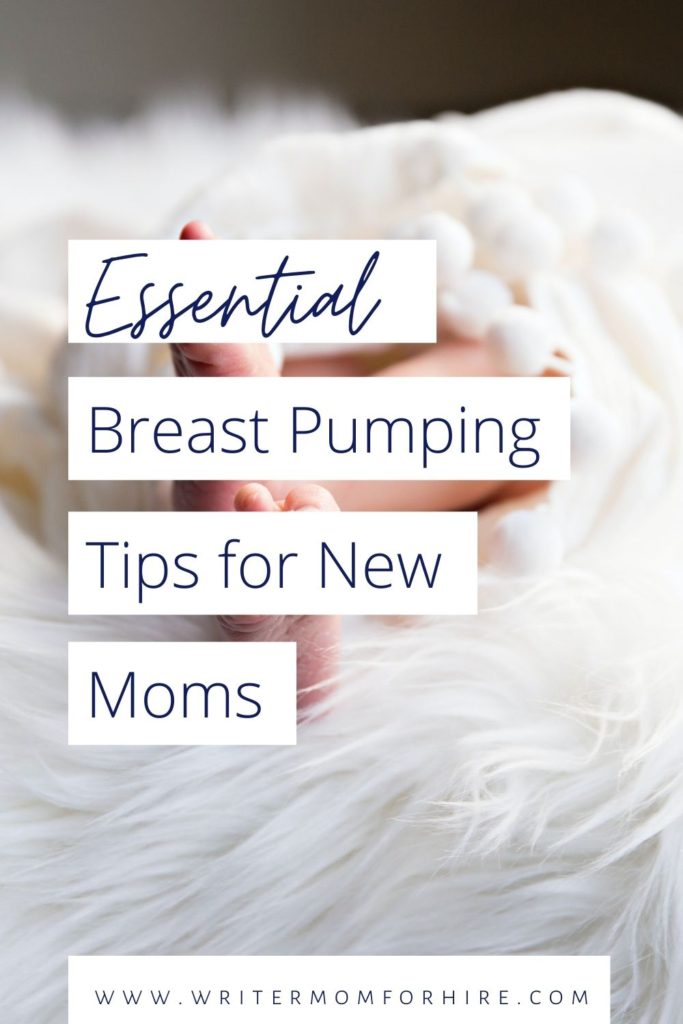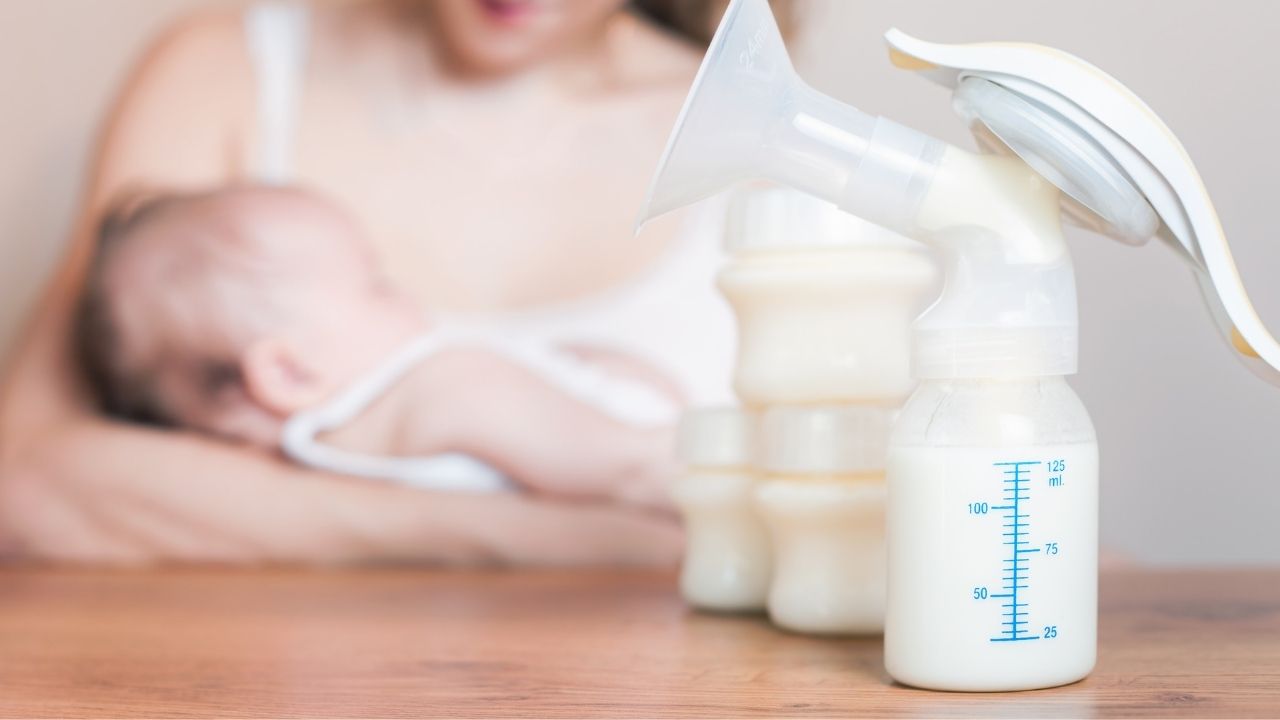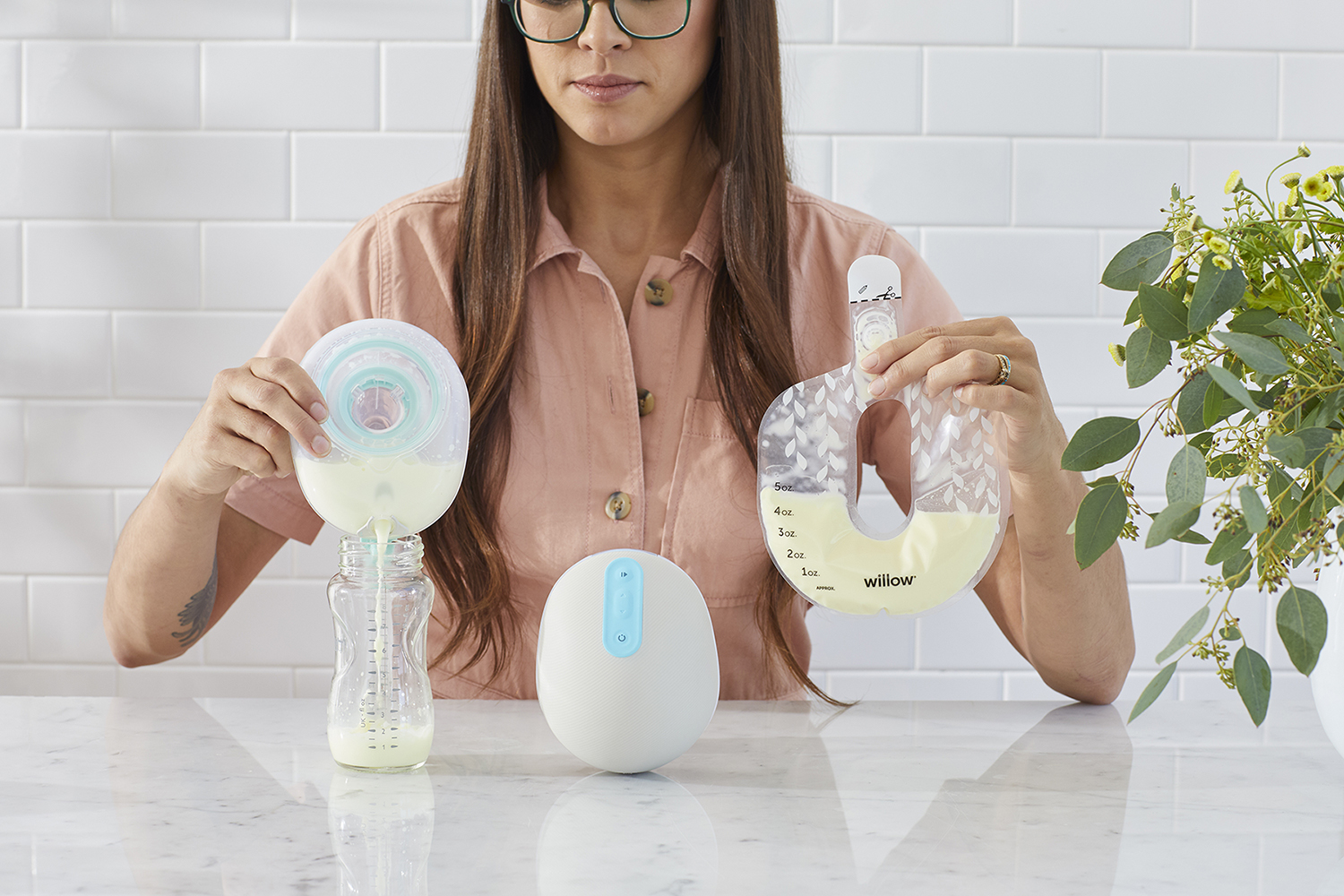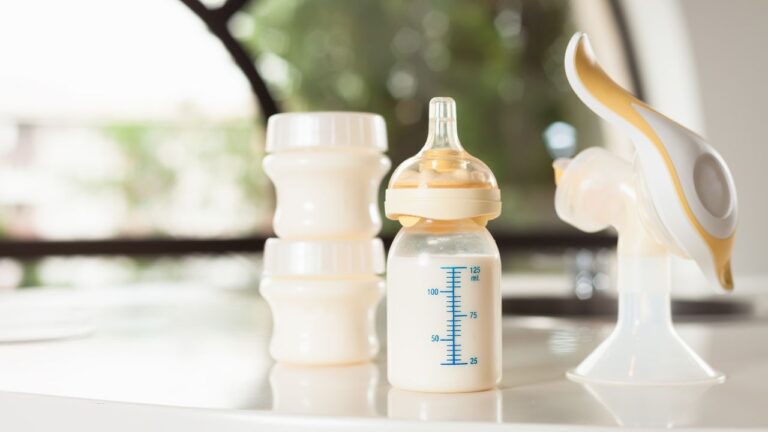Breast Pumping Tips for New Moms — Everything You Need to Know
This post may contain affiliate links and we may earn commissions when you make a purchase through these links (at no extra cost to you). See our disclosure policy for more details.
Frequently Asked Questions, Answered + 10 Breast Milk Pumping Tips
If you’re about to start your pumping journey for the first time ever, then you’re probably on the hunt for breast pumping tips for new moms.
Well, good news! I’ve got you covered.
Here you’ll find the answers to some of the most commonly asked questions about pumping breast milk, plus ten of the best additional breast milk pumping tips I could come up with.
Although I mainly nursed my two babies, I did end up having to pump at times, and there was a lot I had to learn on the fly.
So if you haven’t even started pumping yet, you’re going to be well ahead of the game! Here’s everything you need to know about expressing breast milk for your newborn.

I am not a medical professional, and this information is not intended to replace medical advice.
When to Start Pumping Breast Milk
In theory, you can start pumping at any time (and should begin immediately if you’re exclusively pumping). But if you hope to establish nursing first, you might be wondering how early is too early to pump breast milk.
This can be a little tricky to answer due to a few different factors:
- First of all, you’ll want to establish a good breastfeeding relationship before introducing a bottle to avoid nipple confusion.
- But if you are going back to work and need your baby to get used to drinking from a bottle, you don’t want to wait too long, or your baby might refuse the bottle.
- Not to mention you don’t really want to mess with your supply while your body is still trying to figure out how much to make.
The general rule of thumb is to wait until your baby is 4-6 weeks old.
But like I said, it could vary depending on a number of factors. If you’re going back to work early, then you might want to introduce a bottle slightly earlier than the recommendation.
And if you’re going to be staying at home with your new little one, then you might not have to pump at all.
Other factors to consider: you might need to get rid of a clogged duct or express just enough to relieve extremely full breasts (and avoid a firehose letdown).
How Much Milk Should I Be Pumping?
If you’re exclusively pumping, you should try to maintain an output of about 25-35 ounces every 24 hours (once your supply has been established).
Of course, you won’t be able to pump this much on Day 1, and that’s totally fine since babies drink so little in the beginning.
Often, nursing mommas worry that they’re not producing enough milk for their babies because they can “only” pump a couple ounces in a session.
This is actually not as big of a deal as you might think! Because:
- Our bodies all produce and store milk in different amounts.
- Your body might not respond to a pump as well as it does to your baby.
- Babies who are breastfed on demand might only drink a couple of ounces at a time, while bottle fed babies often drink more. Partly because drinking from a bottle is “easier” for babies than latching onto a breast.
Finally, the amount you’re able to express could vary depending on when (and for how long) your baby last nursed.
So getting .5 to 2 ounces total in a session is perfectly normal (although you may be able to pump more than that) — all depending on the above factors.
Recommended Reading: Best wearable breast pump for pumping on the go — Willow vs. Elvie
How Often Should I Pump to Increase Milk Supply?
You’re probably already aware that milk production is based on supply and demand. The more you nurse or pump, the more milk your body makes. Sounds great, right?
So, what if you genuinely have a low milk supply and need to increase it? You’ll want to power pump.
Here’s how you do that.
In place of a normal nursing/pumping session:
- Pump for 20 minutes
- Rest for 10 minutes
- Pump for 10 minutes
- Rest for 10 minutes
- Pump for 10 minutes
While pumping, massage the breasts and hand express to get more milk. Also, you’ll need to “dry pump” even when there’s no milk coming out.
Do this at least 2-3 times a day for 2-3 days in a row.
How Do I Know When a Breast is Empty?
Here’s the deal: They’re never completely empty.
Your breasts are in a continual cycle of making milk as it’s removed, and even after pumping, you’ll still have about a third of its capacity left.
Our bodies are crazy, miraculous things.
Anyway, I think the question we’re really asking is: how do I know when to stop pumping?
You’ll know that they’re well-drained when your breasts are soft and no longer feel full. Your milk will stop flowing for a while.
You can either choose to end your pumping session now, or you can continue dry pumping until your milk lets down (starts flowing) again.
Can I Pump Into the Same Bottle All Day?
Combining cold and warm milk is NOT safe — adding warm milk will slightly raise the temperature of the cold milk, allowing bacteria to grow.
If you want to store all of that day’s milk in one container, you’ll want to first refrigerate the fresh milk before mixing it together. Once cool, it’s safe to combine it all together.
Do I Need to Wash the Breast Pump After Every Use?
If you don’t want to wash your pump parts after every use, you’ll need to store them in the refrigerator to prevent bacteria from growing on them.
Some suggest rinsing them off before storing in the fridge, but I prefer to put them into a gallon size ziploc baggie without rinsing. I would rather not risk introducing bacteria this way.
You can also get a packet of quick clean pump part wipes to wipe them down in between sessions — plus, they work great for cleaning changing tables, high chairs, cribs, countertops, toys, and more.
You should still wash (in a designated basin rather than the sink) and sterilize them at the end of each day, then let them air dry.
10 Breast Pumping Tips for New Moms
Pumping really isn’t that complicated, although there are certainly some important questions that need to be answered when you’re first getting started.
Hopefully we’ve already covered some of the biggest questions you might have had…
Because now we’re comin’ in hot with ten essential breast pumping tips for new moms!
1. Massage your breasts while pumping.
Massage or breast compressions before/while pumping can stimulate your milk-producing glands, allowing for a faster letdown.
Another benefit is that it can help you drain more milk from the ducts.
You might want to get a hands-free pumping bra so you can use both hands to do the compressions or massage while the pump does its job.
Compressions
Use the hand that is on the same side as the breast you’re compressing. Form a C shape with your thumb and index finger.
Place the index finger under the breast and thumb on top, making sure you don’t get too close to the flange.
Gently squeeze, then release, in a pulsating pattern (you can match the pattern of your pump if you’d like). You can also hold it for a few seconds before releasing.
Massage
Press your index and middle fingers together, then begin at the top of the breast and apply gentle pressure, moving your fingers in a circular movement.
Work your way down toward the areola, stopping before you reach the area under the flange.
Continue doing this all around the breast, including underneath.
2. Consider a wireless breast pump for pumping “on the go”.
Are you going to be spending a LOT of your time pumping? Does the thought of being attached to an outlet for hours every day terrify you?
Then you might want to consider investing in a wireless breast pump, like Willow or Elvie.
A few things you might want to know:
- They’re easy to use and the parts are dishwasher safe.
- You place it inside your nursing bra, and your hands are free to do other things while the pump does all the work.
- If it’s wireless, you can freely move around — you don’t have to plug it in.
- They are typically quieter than a standard electric pump.
- You should be able to use HSA/FSA funds to pay for it (if insurance doesn’t cover it).
If you’re interested, but you’re not sure which one would be a better fit for you, here is a comparison of the two best wearable breast pumps to help you figure it out.
3. Invest in a second (or third) set of pump parts.
If you’re pumping daily, you’ll soon find that it’s a huge pain to clean and dry the parts every night.
You might want to invest in a second or third set of pump parts to make that process easier.
4. Store used pump parts in the fridge between pumping sessions.
We already touched on this earlier, but in case you missed it: you don’t have to wash and/or sterilize your pump parts in between each use!
When I was pumping at work, I would put my pump parts in a gallon size ziploc bag, then I’d keep them in the fridge and use again later.
You don’t even have to rinse between uses — just wipe them down with quick clean pump part wipes as well.
I kept an ice pack in the freezer, then I’d toss it into my cooler bag before heading home at the end of the day (to keep my milk cool).
I did the same thing if I pumped at home — I’d just keep the used parts in the fridge, in case I needed to pump again later that day.
Of course, you’ll still want to clean and dry your pump parts at the end of each day.
5. Keep a manual pump as a backup.
If you frequently rely on your electric pump, you could end up in big trouble if the power goes out, you’re traveling and there’s nowhere to plug in, etc.
But if you have a handy little manual pump (I used and loved this one!), you’ll be golden! They’re inexpensive, and it’s super easy to pump a few ounces on the fly.
The only drawback is that it does take a bit of physical exertion (i.e. your hands could get pretty sore!) so if you have to pump “on the go” pretty frequently, I would definitely consider a wireless wearable breast pump instead.
6. Make sure the breast shields fit properly.
Believe it or not, you can get various sizes of shields for your pump, and the standard shield that comes with your pump might not work well for you.
Most pumps come with at least a couple different sizes, ranging from 21 mm to 36 mm. The size you need is the size of your nipple (you can measure it using a ruler, but be sure to only measure the nipple — not including the areola).
If you don’t have the right size, you could experience a number of issues. For example, your breasts might drain unevenly, leading to blocked milk ducts. You could also experience nipple damage, and even cuts.
7. Don’t skip pumping sessions.
If you aren’t able to fit in a full pumping session, don’t skip it altogether! Even five minutes could help to keep your supply up.
Skipping too many sessions is a sure way to lessen your milk supply, so if you want to continue giving your baby breastmilk, be sure to avoid skipping sessions.
And if you normally breastfeed, but you give your baby a bottle every once in a while? Pump right around the same time! Otherwise, again, you risk losing your supply.
If you aren't able to fit in a full pumping session, don't skip it altogether! Even five minutes could help to keep your supply up.Click To Tweet8. Pump first thing in the morning.
Since the milk-making hormones are higher overnight, a lot of moms are able to pump the most milk first thing in the morning.
If you’re having trouble pumping enough milk, be sure to pump right away in the morning.
It’s completely normal to have a lower output in the evening hours, so if you’re a pumping mama, you’ll definitely want to take advantage of the early mornings!
9. Be sure to store milk properly.
According to the CDC: wash your hands well with soap and water before handling breast milk. If soap and water are not available, use an alcohol-based hand sanitizer that contains at least 60% alcohol.
A few guidelines:
- Use breast milk storage bags or clean food-grade containers with tight fitting lids made of glass or plastic to store expressed breast milk.
- Avoid bottles with the recycle symbol number 7, which indicates that the container may be made of a BPA-containing plastic.
- Never store breast milk in disposable bottle liners or plastic bags that are not intended for storing breast milk.
- Freshly expressed or pumped milk can be stored:
- At room temperature (77°F or colder) for up to 4 hours.
- In the refrigerator for up to 4 days.
- In the freezer for about 6 months is best; up to 12 months is acceptable. Although freezing keeps food safe almost indefinitely, recommended storage times are important to follow for best quality.
Of course, you’ll also want to follow the appropriate guidelines for thawing it to feed your baby in order to ensure your baby’s safety.
10. Take care of yourself.
Last, but of course not least, you need to take care of yourself when breastfeeding or breast pumping.
I know, I know. Easier said than done.
But sleeping, eating, hydrating… They’re all incredibly important during this time. Enlist help if you can (and sometimes you need to hire help with certain tasks, such as grocery shopping or cleaning the house).
Do what you can to take care of yourself, and your body will thank you.
Recommended Reading: How to Clean Breast Pump Tubing (& Properly Dry It)
BONUS: Freeze “Milk Cubes”
Wondering how to freeze breast milk in ice cube trays so that you can quickly grab a couple ounces at a time – without having to thaw an entire bag of frozen milk?
Here’s a hint: Use cylindrical Milkies Trays so you can pop them out and into and size bottle opening for thawing.
You’ll find more on how to freeze breast milk in ice cube trays here.
Final Thoughts
And there we have it — some of the most commonly asked questions new moms have about breast pumping, plus ten additional tips for a successful pumping journey.
Do you have any further questions or comments? Please share them below!
Helpful Breast Pumping Tools
Here is a recap of some of the recommended items that will help make your pumping journey the best it can be!








